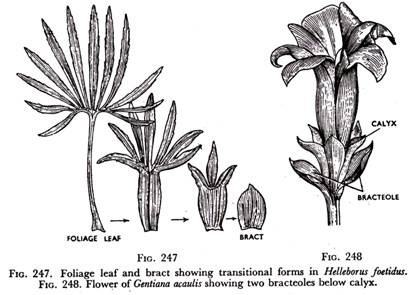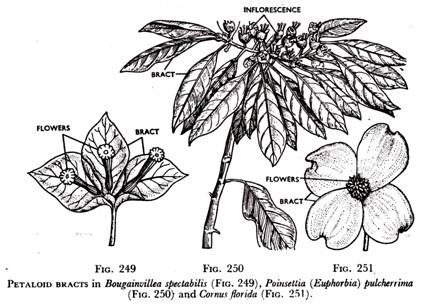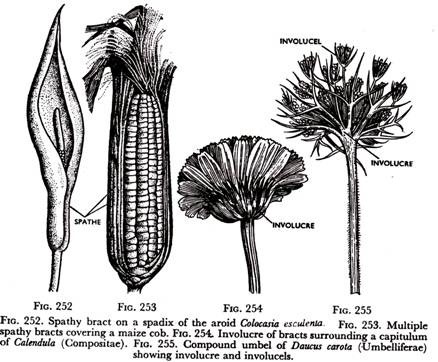ADVERTISEMENTS:
The below mentioned article will highlight the nine important types of bracts and bracteoles in plants.
They are: (1) Leafy or Foliaceous Bract (2) Petaloid Bract (3) Spathy Bract (4) Involucral Bract (5) Scaly Bract (6) Cupule (7) Epicalyx (8) Glume and (9) Lemma and Palea.
Bracts (hypsophylls ) are special leaves at whose axils the flowers are borne. They are not always present and, if a bract is found, the flower is called bracteate while, if it is absent as in the families Cruciferae and Boraginaceae, the flower is ebracteate.
ADVERTISEMENTS:
Bracts may drop off early (deciduous) or they may be persistent, When bracts are present, they serve for the protection of flower buds in the young stage. Morphologically, a bract may be formed by the entire phyllopodium or a part of it.
Some shoots show transitional forms between normal leaves and bracts . Additional bract-like small and thin structures are sometimes borne on the peduncle or the pedicel between the flower and the bract. These are called bracteoles and are of the nature of prophylls .
Bracts and bracteoles may present various appearances some of which are described below:
Type # 1. Leafy or Foliaceous Bract:
Bracts resembling ordinary green foliage leaves may be seen in the china-rose. (Hibiscus rosa-sinensis) and a number of other plants like Acalypha indica (Euphorbiaceae), Adhatoda zeylanica (Acanthaceae), Gynandropsis (Capparidaceae), etc.
Type # 2. Petaloid Bract:
Bracts sometimes become brightly coloured simulating petals and perform the same function. These may easily be mistaken for petals. Beautiful examples are Bougainvillea spectabilis of Nyctaginaceae where three flowers cluster together and the large bracts are conspicuously bright red or orange, Poinsettia (Euphorbia) pulcherrima of Eupborbiaceae with large leaf-shaped but brightly coloured red or orange bracts, and Cornus sp. (dogwood) of Cornaceae where the conspicuously large white bracts forming a whorl surrounding the cluster of small flowers in the centre, exactly look like a whorl of petals.
Type # 3. Spathy Bract:
These are large, thick, boat-shaped bracts called spathes covering the whole or a part of a spadix inflorescence. These are often very large as seen in the inflorescence of Amorphophallus titanum .
In some palms the spathe is as much as twenty feet long. It is seen in many other plants like arum, maize , banana ,etc. Spathes also occur in some other types of inflorescences, e.g., the spike of Polyanthes .
It may be either green or coloured yellow, purple, etc. In some palms the spadix is branched, the branches being covered by separate spathes which are sometimes given a special name, spathellae.
Type # 4. Involucral Bract:
In an inflorescence of the capitulum type found in the family Compositae, whorls of green sepaloid bracts occur around the base of the inflorescence. These form an involucre. Sometimes bases of these bracts fuse forming a cup-shaped structure.
Such an involucre of bracts is also seen in the family Umbelliferae where, as in carrot (Daucus carota ), the inflorescence is a compound umbel and there is an involucre at the base of the whole inflorescence.
There are also smaller involucres (called involucels or partial involucres) round the base of each branch of the inflorescence.
Type # 5. Scaly Bract:
Each individual floret of a capitulum often possesses its own scaly braci different from the involucral bracts. Scaly bracts are also seen interspersed between the florets of catkin and cyathium inflorescences .
ADVERTISEMENTS:
In the strobile inflorescence of hop (Humulus lupulus ) which is used in the manufacture of beer, each flower is borne in the axil of a stiff, scaly, persistent bract.
Type # 6. Cupule:
The acorn of oak and similar fruits of birch (Betula) and hazel (Corylus ), etc., of Cupulifereae possess a number of hard and woody bracts or bracteoles at the base of the flower somewhat like an involucre.
As the fruit matures, these bracts fuse together forming a cup-shaped structure called cupule covering the base of the oak acorn and a similar husky structure is formed below the hazel nut.
Type # 7. Epicalyx:
ADVERTISEMENTS:
In the family Malvaceae, as in china-rose , a whorl of sepaloid green bracteoles occur just below the calyx and is called the epicalyx.
Such an epicalyx is also seen below the calyx of the strawberry (Fragaria of Rosaceae ). An epicalyx is sometimes called an involucres because of the apparent resemblance.
Type # 8. Glume:
Each spikelet of the family Graminaceae bears as its base two scaly bracts called glumes or empty glumes.
Type # 9. Lemma and Palea:
Each flower in a spikelet of Gramineae bears a bract called lemma or the flowering glume which is sometimes awned at the tip, and a bracteole called palea which fits within the lemma.



